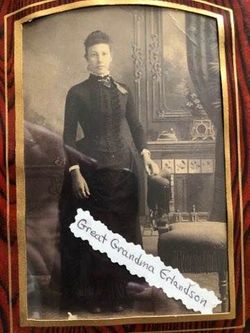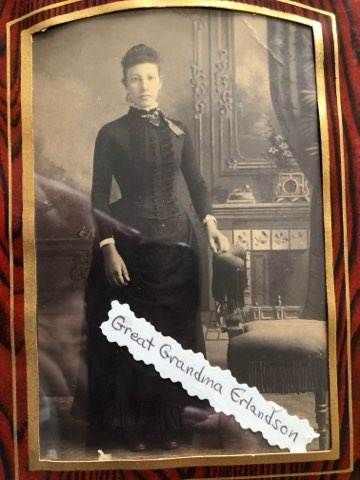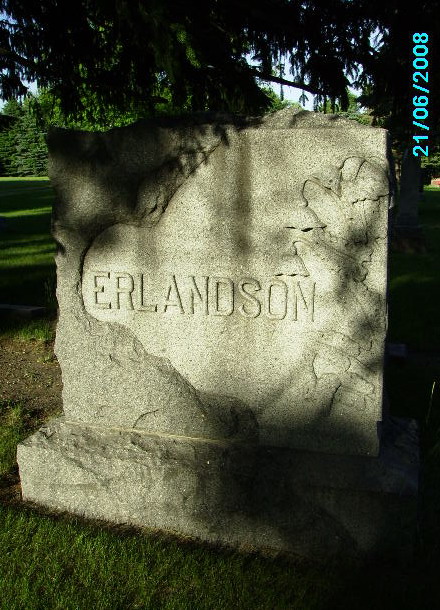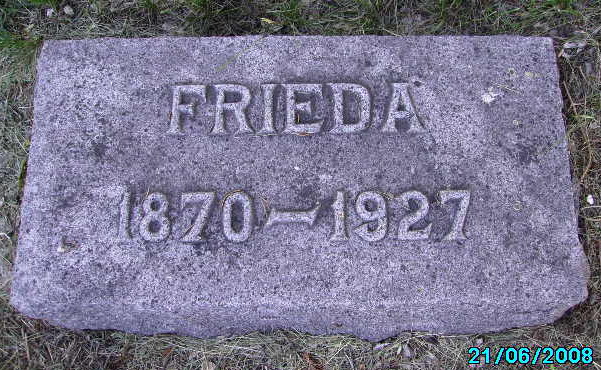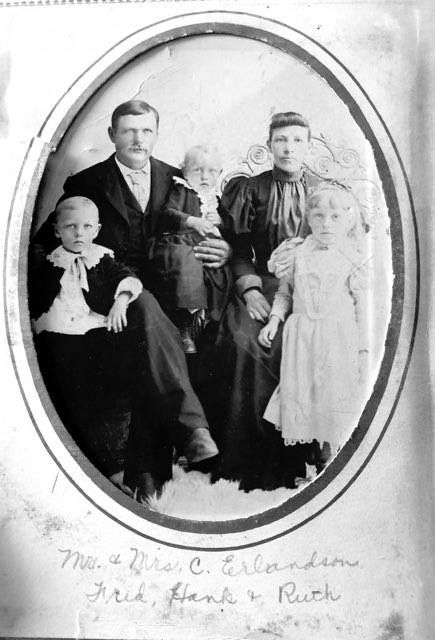In 1862, Carl A. Erlandson was born in Nordsjo, Sweden. He came to the United States with his younger sister, Emma. They stayed in Sacred Heart, Minnesota with their cousins. Emma then went to Minneapolis to work for Pillsbury. Later she moved to Chicago. She belonged to the Salvation Army, a Protestant Christian church. Carl worked in Sacred Heart for awhile and then for Reverand Lindren on his farm in Maxwell Township. That is how Carl ended up in Dawson when the Dawson Covenant Church was organized in 1889. In 1890 he bought the farm West of the church and he and his wife lived on that farm the rest of their lives. The farm was sold 21 years after Frieda Erlandson has passed away. Carl was Sunday School Superintendent of the church (except for 2 years) until he passed away. Carl was also chairman of the church for 19 years. Carl loved his church and all that was connected with it. Mrs. Frieda Erlandson was a quiet home person, so she was not involved in the activity of the church work. Carl and Frieda always had the traveling pastors or the single pastors live in their home.
Fred, the oldest son, was the Sunday School Superintendent for a few years after his father's death, but Fred moved with his wife and children to Highmore, SD to organize a church there and so became charter members. Later Carl and Frieda's grandson, Paul Bergman, was Sunday School Superintendent. It seems this position was the most loved branch of the church. Now in 1959, Fred, Henry, and William have passed away. Judy and Ruby have moved to California. Judy works in a hospital in Alemeda for 20 years. Ruby was married and raised a family and now is doing the same work as she did in Minnesota which is a welfare worker in her county in California.
Carl and Frieda's farm was sold in 1948 to George F. Lund so none of the Erlandsons live out there now. Carl and Frieda's youngest son, Ervin, lives in Dawson. Fred's family all live in South Dakota except Wilton who lives at Norfolk, Virginia. Ruth and Sam moved to Milan; Paul to California; Virginia lives in Washington DC. Lucille and her husband are missionaries in Japan. They are on their second term, but plan to be back the United States by 1961.
(updated by Melissa Neal Habeck)
Surnames: Family surnames of Norwegians can be confusing for us in the United States because of the custom that was used in Norway during the 1800s. In addition, when immigrants came to the USA, many changed or modified their names. This brief section summarizes the general practice of naming children and of linking names to the place where the families lived.
In rural areas of Norway, it was customary for a son to take his surname form his father's first name. For example, Anton Jensen Valstad's father's name was Jens Andorsen. A girl, if the daughter of Hans, her surname became Hansdatter. Many adopted the name of the place where they came from ending in -dahl (valley), -fjeld (mountain), -gaard (farm), -stad (town), etc.
Up until about 1900, people living in rural Norway were identified by three names: a given name, the patronymic showing descent, and the farm name. The first son was usually named for the father's father, the first daughter for the father's mother. The second son was named for the mother's father. Successive children were named after deceased siblings, deceased aunts and uncles, grandparents, etc. For example, John and Inga Jensen apparently named their son, Clarence Older, born in 1916, after the second son of Hans Peter and Lena Jensen who died at an early age of 11 from typhoid fever in 1910. The patronymic name was a permanent name that did not change when a girl married. The Danish form of the patronymic name is usually "sen" and the Swedish form "son". Since Norway was ruled by Denmark for four centuries, the Danish form of spelling is common in records in Norway.
The farm name is the third name of a Norwegian. The farm name was established very early and belonged permanently to the farm, or fragment of a farm-being used as an address. When a person moved, he took the name of the new farm for his third name. the use of surnames was unknown to the immigrant. When he arrived, he had to learn a new language and adopt a new naming system. At first they generally used the patronymic name, but later many began using the farm name.
In 1862, Carl A. Erlandson was born in Nordsjo, Sweden. He came to the United States with his younger sister, Emma. They stayed in Sacred Heart, Minnesota with their cousins. Emma then went to Minneapolis to work for Pillsbury. Later she moved to Chicago. She belonged to the Salvation Army, a Protestant Christian church. Carl worked in Sacred Heart for awhile and then for Reverand Lindren on his farm in Maxwell Township. That is how Carl ended up in Dawson when the Dawson Covenant Church was organized in 1889. In 1890 he bought the farm West of the church and he and his wife lived on that farm the rest of their lives. The farm was sold 21 years after Frieda Erlandson has passed away. Carl was Sunday School Superintendent of the church (except for 2 years) until he passed away. Carl was also chairman of the church for 19 years. Carl loved his church and all that was connected with it. Mrs. Frieda Erlandson was a quiet home person, so she was not involved in the activity of the church work. Carl and Frieda always had the traveling pastors or the single pastors live in their home.
Fred, the oldest son, was the Sunday School Superintendent for a few years after his father's death, but Fred moved with his wife and children to Highmore, SD to organize a church there and so became charter members. Later Carl and Frieda's grandson, Paul Bergman, was Sunday School Superintendent. It seems this position was the most loved branch of the church. Now in 1959, Fred, Henry, and William have passed away. Judy and Ruby have moved to California. Judy works in a hospital in Alemeda for 20 years. Ruby was married and raised a family and now is doing the same work as she did in Minnesota which is a welfare worker in her county in California.
Carl and Frieda's farm was sold in 1948 to George F. Lund so none of the Erlandsons live out there now. Carl and Frieda's youngest son, Ervin, lives in Dawson. Fred's family all live in South Dakota except Wilton who lives at Norfolk, Virginia. Ruth and Sam moved to Milan; Paul to California; Virginia lives in Washington DC. Lucille and her husband are missionaries in Japan. They are on their second term, but plan to be back the United States by 1961.
(updated by Melissa Neal Habeck)
Surnames: Family surnames of Norwegians can be confusing for us in the United States because of the custom that was used in Norway during the 1800s. In addition, when immigrants came to the USA, many changed or modified their names. This brief section summarizes the general practice of naming children and of linking names to the place where the families lived.
In rural areas of Norway, it was customary for a son to take his surname form his father's first name. For example, Anton Jensen Valstad's father's name was Jens Andorsen. A girl, if the daughter of Hans, her surname became Hansdatter. Many adopted the name of the place where they came from ending in -dahl (valley), -fjeld (mountain), -gaard (farm), -stad (town), etc.
Up until about 1900, people living in rural Norway were identified by three names: a given name, the patronymic showing descent, and the farm name. The first son was usually named for the father's father, the first daughter for the father's mother. The second son was named for the mother's father. Successive children were named after deceased siblings, deceased aunts and uncles, grandparents, etc. For example, John and Inga Jensen apparently named their son, Clarence Older, born in 1916, after the second son of Hans Peter and Lena Jensen who died at an early age of 11 from typhoid fever in 1910. The patronymic name was a permanent name that did not change when a girl married. The Danish form of the patronymic name is usually "sen" and the Swedish form "son". Since Norway was ruled by Denmark for four centuries, the Danish form of spelling is common in records in Norway.
The farm name is the third name of a Norwegian. The farm name was established very early and belonged permanently to the farm, or fragment of a farm-being used as an address. When a person moved, he took the name of the new farm for his third name. the use of surnames was unknown to the immigrant. When he arrived, he had to learn a new language and adopt a new naming system. At first they generally used the patronymic name, but later many began using the farm name.
Family Members
Sponsored by Ancestry
Advertisement
Explore more
Sponsored by Ancestry
Advertisement
